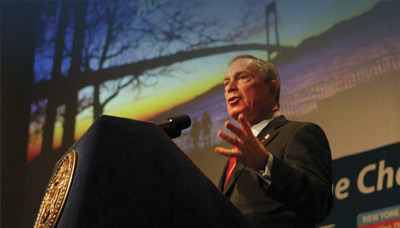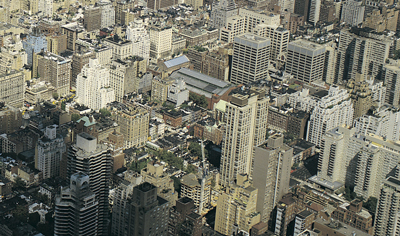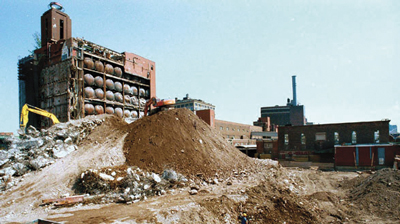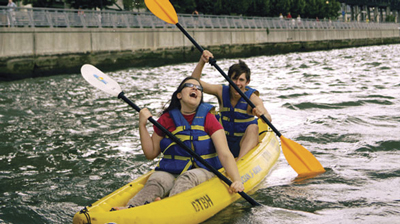MAYOR BLOOMBERG PRESENTS PLANYC: A GREENER, GREATER NEW YORK
THE
MOST SWEEPING PLAN TO ENHANCE NEW YORK'S URBAN ENVIORNMENT IN THE CITY'S MODERN HISTORY
 2030 2030

APRIL
22, 2007—Earth Day Event at the Museum of Natural History Unveils
Policy Speech with 127 Initiatives to Make New York More Sustainable
Including Reducing Carbon Emissions by 30%
Mayor
Michael R. Bloomberg presented PlaNYC: A Greener, Greater New York in
a sweeping policy speech containing 127 separate initiatives at the
American Museum of Natural History.
PlaNYC
is the culmination of thousands of hours of work, informed by public
meetings and feedback from New Yorkers designed to achieve the sustainability
goals that the Mayor laid out in a December 12, 2006 speech at the Queens
Museum.
Those
goals include:
- housing
an additional 1 million New Yorkers affordably;
- increasing
access to parks, playgrounds and open spaces;
- reclaiming
brownfields;
- developing
critical backup systems for our aging water network to ensure reliability;
- providing
additional reliable power sources and upgrading our existing power
plants;
- reducing
water pollution so we can open our waterways for recreation; and
- reducing
our greenhouse gas emissions by 30%.
In early April 2007, the Mayor released New York’s first ever
comprehensive inventory of greenhouse gas emissions which was the first
step towards achieving major emissions reductions.
“With
historically low unemployment, a low crime rate and better schools,
New York is thriving – it’s a place where people want to
be.
The
time to build on our success is now, and I will not spend my last 984
days in office ignoring the problems that this City will face in the
future. We need to start meeting the challenges we’ll face as
we grow by nearly 1 million people, and we’ll do it by working
to enact these 127 policy initiatives,” said Mayor Bloomberg.
“We need to increase open space, expand housing, deal with our
congested roadways, create better mass transit options, increase our
energy sources and stabilize our water supply or we simply won’t
be able to continue the high quality of life we now enjoy. If we act
now we’ll have a better future, a better quality of life, and
more importantly, our children and their children will too.
THE
PLAN
In
December 2006, Mayor Michael R. Bloomberg challenged New Yorkers to
generate ideas for achieving 10 key goals for the city’s sustainable
future. New Yorkers in all five boroughs responded. The result is the
most sweeping plan to enhance New York’s urban environment in
the city’s modern history. Focusing on the five key dimensions
of the city’s environment—land, air, water, energy, and
transportation—we have developed a plan that can become a model
for cities in the 21st century. The combined impact of this plan will
not only help ensure a higher quality of life for generations of New
Yorkers to come; it will also contribute to a 30% reduction in global
warming emissions.

LAND - HOUSING
“To
accommodate nearly a million more New Yorkers we are going to have to
create hundreds of thousands of new homes - even on top of our existing
affordable housing plan - the largest ever undertaken by any city. To
do it, and to build those new homes at lower costs, we have to make
more land available for new housing, which will help ease pressure on
land prices,” said Mayor Bloomberg.
To
meet the needs of a growing population, we’ll need 265,000 more
housing units by 2030. We have the capacity to accomodate this growth—but
without action our city’s housing stock won’t be as affordable
or sustainable as it should be. that’s why we will expand our
supply potential to drive down the price of land—while directing
growth towards targeted areas served by public transportation. We will
pair these actions with targeted affordability strategies like creative
financing, inclusionary zoning, and home ownership programs for low-income
New Yorkers. By expanding these efforts into the future, we can ensure
that new housing production mathces our vision of New York as a city
of opportunity for all.
Housing
Initiatives
- Pursue
transit-oriented development.
Use upcoming rezonings to direct growth toward areas with strong transit
access
- Reclaim
underutilized waterfronts
Continue restoring underused or vacant waterfront land across the
city
- Increase
transit options to spur development
Use transit extensions to spark growth as the subways did more than
a century ago
- Expand
co-locations with government agencies
Pursue partnerships with City and State agencies throughout the city
- Adapt
outdated buildings to new uses
Seek to adapt unused schools, hospitals, and other outdated municipal
sites for productive use as new housing
- Develop underused areas to knit neighborhoods together
• Continue to identify underutilized areas across the city that
are well-served by transit and other infrastructure
• Examine the potential of major infrastructure expansions to
spur new growth in neighborhoods
- Deck
over rail yards, rail lines and highways
Explore opportunities to create new land by constructing decks over
transportation infrastructure
- Develop
new financing strategies
Continue to pursue creative financing strategies to reach new income
brackets
- Expand inclusionary zoning
Seek opportunities to expand the use of inclusionary zoning, harnessing
the private market to create economically integrated communities
- Encourage
home ownership
Continue to develop programs to encourage home ownership, emphasizing
affordable apartments over single-family homes
- Preserve
the existing stock of affordable housing throughout New York City
Continue to develop programs to preserve affordable housing that so
many New Yorkers depend upon today

LAND
- OPEN SPACE
“Some
of our brownfields may also become open space and parkland, which bind
communities together. In the past five years alone we’ve added
more than 300 acres to the biggest and best parks system in the nation.
But still, nearly 2 million New Yorkers live too far from parks and
playing fields,” said Mayor Bloomberg.
Although
we’ve added more than 300 acres of parks in the last five years,
more than two million New Yorkers live more than ten minutes from a
park. This shortage of open space threatens our environment, our health,
and our quality of life. That’s why we will invest in new recreational
facilities across every borough, opening hundreds of schoolyards as
local playgrounds, reclaiming undeveloped sites that were designated
as parks but never finished, and expanding useable hours at existing
fields by installing lights and turf fields. We will re-imagine our
streets and sidewalks by adding new greenstreets and public plazas in
every community as part of our strategy to create a more inviting public
realm.
Open
space initiatives
- Open
schoolyards across the city as public playgrounds
Open schoolyards as playgrounds in every neighborhood
- Increasing options for competitive athletes
Make high-quality competition fields available to teams across the
city
- Complete underdeveloped destination parks
Fulfill the potential of at least one major undeveloped park site
in every borough
- Provide more multi-purpose fields
Convert asphalt into multi-use fields
- Install new lighting
Maximize time on our existing turf fields by installing lights for
nighttime use
- Create a public plaza in every community
Create a new or enhance an existing public plaza in every community
- Green our underutilized street and sidewalk space
• Fill every available street tree opportunity in New York City
• Expand Greenstreets program

LAND
- BROWNFIELDS
Our
need to maximize the efficiency of every piece of land means that we
must foster the reuse of brownfields, or sites where previous uses have
left behind contamination. In order to promote the redevelopment of
these sites, we will make existing brownfield cleanup programs faster
and more efficient. We will enroll more sites in remediation programs,
and ensure that those sites are redeveloped with even greater community
involvement. Across New York, our approach to brownfields will be more
proactive, more comprehensive, and more inclusive than ever before,
as we work to ensure that the remnants od our industrial past contribute
to a more sustainable future.
Brownfield
inititatives
- Adopt
on-site testing to streamline the cleanup process
Pilot the “Triad” program on two sites
- Create remediation guidelines for New York City cleanups
Analyze New York City’s soil and develop a set of standard cleanup
remedies appropriate to the city
- Establish a city office to promote brownfield planning and redevelopment
Create a new City office to increase resources dedicated to brownfield
planning, testing and cleanups
- Expand
participation in the current State Brownfield Clean-up Program (BCP)
Ask State to redistribute BCP tax credits to relieve budgetary pressures,
and begin covering New York City-specific contamination
- Create a city program to oversee all additional clean ups
Create a City-sponsored program to provide oversight of cleanups for
any sites not enrolled in other programs
- Provide incentives to lower costs of remediation
Dedicate $15 million to capitalize a fund to support brownfield redevelopment
- Encourage State to release community-based redevelopment grants
Advocate for State to reform the Brownfield Opportunity Area (BOA)
program and release planning grant funds to community groups
- Incentivize developers to participate in Brownfields Opportunity Area
(BOA) planning
Advocate for financial incentives for developments constructed in
coordination with a BOA
- Launch outreach efforts to educate communities about brownfield redevelopment
Educate, outreach, and provide technical assistance to communities,
private developers, and City agencies to promote brownfield redevelopment
- Create a database of historic uses across New York City to identify
potential brownfields
Conduct a historic use assessment for all city sites in order to measure
long-term progress towards goal
- Limit liability of property owners who seek to redevelop brownfields
Create an insurance program and legal protections to |limit the liability
of developers willing to clean up land they did not pollute
- Launch outreach effort to educate communities about brownfield redevelopment
We will educate, reach out, and provide technical assistance to communities,
private developers, and city agencies to promote brownfield redevelopment

WATER - WATER QUALITY
“New
York is fortunate to have not only a vast supply of fresh water, but
also a wealth of rivers, creeks and coastal waters. From time immemorial,
they nurtured an incredible diversity of marine life. However, for too
long, the city polluted these waters and as our population grew, that
contamination increased. We can change that,” said Mayor Bloomberg.
Waterfront
revitalization has been a guiding principle of the last five years,
with 60 miles of development underway. Now it is time to accelerate
the reclamation of the waterways themselves, particularly our most polluted
tributaries. We will upgrade our wastewater treatment infrastructure,
while implementing proven strategies such as greening our streets, planting
trees and expanding our bluebelt network. We will also explore more
natural solutions for cleansing our water bodies through a range of
pilot programs that will be coordinated by a new inter-agency Best Management
Practices Task Force. These strategies will include new tree-pit designs,
water-cleansing mollusks, and green roofs. Through these initiatives,
we can restore oour city’s natural ecology and recreational use
of our waterways.
Waterways initiatives
- Develop
and implement Long Term Control Plans
Complete Long Term Control Plans for all 14 New York City Watersheds,
as required by law
- Expand
wet weather capacity at treatment plants
Reduce Combined Sewage Overflow (CSO) discharges by more than 185
mgd during rainstorms
- Increase use of High Level Storm Sewers (HLSS)
Initiate Capital HLSS projects where feasible in combined sewer areas
citywide and integrate HLSS into major new developments, where appropriate
- Capture
the benefits of our public realm plan
- Expand Blue Belt Program
Expand Bluebelt in Staten Island and other boroughs, where possible
- Form interagency BMP task
Make the reduction of CSO volumes and other environmental issues a
priority for all relevant City agencies
- Pilot promising Best Management Practices (BMPs)
• Reintroduce 20 cubic meters of ribbed mussel beds
• Design five expanded tree pits and monitor impacts
• Pilot one swale to collect rainwater from roadways
• Pilot additional BMPs
- Require greening of parking lots
Modify the zoning resolution to include design guidelines for off-street
parking lots for commercial and community facilities
- Provide incentives for the installation of green roofs
Encourage the installation of green roofs through a new incentive
program
- Protect
wetlands
Assess the vulnerability of existing wetlands and identify additional
policies to protect them

WATER - WATER NETWORK
We
have the luxury of a stong water supply, but our supply system faces
serious challenges. In order to continue providing reliable water to
8.2 million New York City residents and an additional one million people
upstate, we must ensure the quality of our water at its source by building
a new filtration plant forr the Croton system and continuing our aggresive
protection program for the Catskill and Delaware watersheds. We will
create redundancy for the aqueducts that carry the water to the city
throough a combination of water conservation measures, maximizing the
use of our existing facilities through new infrastructure, and evaluating
new potential water sources. Finally, we must be able to repair and
modernize oour in-city distribution, which means finishing the Water
Tunnel No. 3 and accelerating repairs to water mains.
Water
network initiatives
- Continue
the Watershed Protection Program
Aggressively protect our watersheds as we seek to maintain a Filtration
Avoidance Determination for the Catskill and Delaware Water Supplies
- Construct an ultraviolet disinfection plant for the Catskill/Delaware
systems
Construct an ultraviolet disinfection facility to destroy disease-causing
organisms in our upstate watershed
- Build the Croton Filtration plant
Construct a water filtration plant to protect the Croton supply
- Launch a major new water conservation effort
Implement a water conservation program to reduce citywide consumption
by 60 million gallons a day
- Maximize existing facilities
Add 245 mgd to our supply potential through increased efficiency
- Evaluate new water sources
Evaluate 39 projects to meet the shortfall needs of the city during
a prolonged shutdown of the Delaware Aqueduct
- Complete Water Tunnel No. 3
• Complete construction of stage 2 and begin repairing Water
Tunnel No. 1
• Complete stage 3 and 4 of Water Tunnel No. 3
- Complete a backup tunnel to Staten Island
Replace pipelines connecting Staten Island to Tunnel No. 2
- Accelerate upgrades to water main infrastructure
Increase replacement rate to over 80 miles annually

TRANSPORTATION
“In
analyzing congestion pricing, we studied commuting patterns across the
city, and we arrived at an astounding finding. Of the New Yorkers who
work in Manhattan but live outside it only five percent commute by car,”
said Mayor Bloomberg.
For
the last 50 years, New York has underinvested in its transportation
network. We are now proposing a sweeping, regional transportation plan
that will enable us to improve travel times and achieve the funding
necessary to meet the city’s and the region’s transit needs
through 2030 and beyond. That includes strategies to improve our transit
network and reduce growing gridlock on our roads thrrough better road
management and congestion pricing. We will seek to create a new regional
financing entity, the SMART Financing Authority, that would provide
one-time grants to achive a state of good repair and filll the existing
funding gap for critical transit expansions, enabling our region to
achieve a new standard of mobility.
Transportation
initiatives
- Increase
capacity on key congested routes
Seek to fund five projects that eliminate capacity constraints
- Provide new commuter rail access to Manhattan
Seek to expand options for rail commuters
- Expand transit access to underserved areas
Seek to provide transit to new neighborhoods
- Improve and expand bus service
• Initiate and expand Bus Rapid Transit
• Dedicate Bus/High Occupancy Vehicle (HOV) lanes on the East
River Bridges
• Explore other improvements to bus service
- Improve local commuter rail service
Seek to make better local use of Metro-North and Long Island Rail
Road (LIRR) stations
- Improve access to existing transit
Facilitate access to subways and bus stops citywide
- Address congested areas around the city
Develop congestion management plans for outer-borough growth corridors
- Expand ferry service
Seek to expand service and better integrate it with the city's existing
mass transit system
- Promote Cycling
• Complete the City's 1,800-mile bike master plan
• Facilitate cycling
- Pilot congestion pricing
Seek to use pricing to manage traffic in the Central Business District
(CBD)
- Manage roads more efficiently
• Expand the use of Muni Meters
• Create an integrated traffic management system
- Strengthen enforcement of traffic violations
• Expand the force of Traffic Enforcement Agents (TEAs)
• Enable all TEAs to issue blocking-the-box tickets
• Expand the use of traffic enforcement cameras
- Facilitate freight movements
• Improve access to John F. Kennedy International Airport (JFK)
• Explore High Occupancy Truck Toll (HOTT) Lanes
- Close the Metropolitan Transit Authority's State of Good Repair gap
Seek a grant from the SMART Authority to cover the MTA's funding gap
- Close the City's road and bridge state of good repair ga
• Seek a grant from the SMART authority to cover the City Department
of Transportation funding gap
• Invest in bridge and tunnel upgrades
- Establish a new regional transit financing authority
Seek to create a Sustainable Mobility and Regional Transportation
(SMART) Financing Authority to advance new projects and achieve a
state of good repair

ENERGY
“As
we grow, and if summers continue to get warmer, the strain will increase
resulting in more breakdowns, more polluted air, and rising energy bills.
In fact, if we do nothing, the city’s total energy bill will increase
by $3 billion by 2015.
New
Yorkers face rapidly-rising energy costs and carbon emission from an
ineffective market, aging energy infrastructure, and growth. Addressing
our energy challenge will require a two-pronged strategy of increasing
our sources of clean supply and lowering our demand. We will encourage
the addition of new, clean power plants, promote repowerings of our
most inefficient plants, and buil;d a market for renewable energies.
To reduce demand, we will target our largest energy consumers and accelerate
energy efficiency upgrades. Together, these strategies will produce
a reliable, affordable, and environmentally sustainable energy network
for New York City. But there is currently no entity capable of executing
these initiatives. That’s why we will work with the State to create
a New York City Energy Planning Board that will help us shape our energy
future.
Energy
initiatives
- Establish
a New York City Energy Planning Board
Work with the State and utilities to centralize planning for the city's
supply and demand initiatives
- Reduce energy consumption by City government
Commit 10% of the City's annual energy bill to fund energy-saving
investments in City operations
- Strengthen energy codes in New York City
Strengthen our energy and building codes to support our energy efficiency
strategies and other environmental goals
- Create an energy efficiency authority for New York City
Create the New York City Efficiency Authority (NYCEEA) responsible
for reaching the city's demand reduction targets
- Prioritize five key areas for targeted incentives
Use a series of mandates, challenges, and incentives to reduce demand
among the city's largest energy consumers
- Expand Promote Peak Load Management
• Expand participation in Peak Load Management Programs through
smart meters
• Support expansion of real-time pricing across the city
- Launch an energy awareness and training campaign
Increase the impact of our energy efficiency efforts through a coordinated
energy education, awareness, and training campaign
- Facilitate repowering and construction of power plants
Facilitate the construction of 2,000 to 3,000 MW of supply capacity
by repowering old plants, constructing new ones, and building dedicated
transmission lines
- Expand Clean Distributed Generation ("Clean DG")
• Increase the amount of Clean DG by 800 MW
• Promote opportunities to develop district energy at appropriate
sites in New York City
- Support expansion of gas infrastructure
Support critical expansions to the city’s natural gas infrastructure
- Foster the market for renewable energy
• Create a property tax abatement for solar panel installations
• Study the cost-effectiveness of solar electricity when evaluated
on a Real Time Pricing scenario
• Support the construction of the city's first carbon neutral
building, primarily powered by solar electricity
• Increase use of solar energy in City buildings through creative
financing
• Work with the State to eliminate barriers to increasing the
use of solar energy in the city
• Pilot one or more technologies for producing energy from solid
waste
• End methane emissions from sewage treatment plants and expand
the productive use of digester gas
• Study the expansion of gas capture and energy production from
existing landfills
- Accelerate reliability improvements to the city's grid
Advocate for Con Edison to implement recommendations from the City's
report on the northwest Queens power outages
- Facilitate grid repairs through improved coordination and joint bidding
• Pursue the passage of joint bidding legislation
• Ensure adequate pier facilities are available to Con Edison
to offload transformers and other equipment
- Support Con Edison's efforts to modernize the grid
Support Con Edison’s 3G System of the Future Initiative

AIR
“In
parts of the Bronx, Brooklyn, and Harlem, children are hospitalized
for asthma at nearly four times the national average. We cannot turn
a blind eye to this outrage. All of our children deserve a healthy start
in life. Many people call that environmental justice; I simply call
it the right thing to do,” said Mayor Bloomberg.
Despite
recent improvements, New York City still falls short of meeting federal
air quality standards. That’s why we will continue pressuring
the State and Federal governments to reduce harmful emissions—while
aggresively targeting the sources we can control. Transportation is
responsible for more than 50% of our local air pollution; as a result,
we will focus on reducing emissions from on and off-road vehicles. We
will also address our other major sources of emissions—buildings
and power plants— by switching to cleaner fuels for heating and
retiring old, polluting plants. Natural solutions such as planting one
million trees will bring us the rest of the way towards the cleanest
air of any big city in the country. To track our progress and target
our solutions more effectively we will launch the largest local air
quality study in the United States.
Air
initiatives
- Capture
the air quality benefits of transportation plan
- Improve fuel efficiency of private cars
• Waive New York City's sales tax on the cleanest, most efficient
vehicles
• Work with the MTA, the Port Authority, and the State DOT to
promote hybrid and other clean vehicles
• Pilot new technologies and fuels, including hydrogen and plug-in
hybrid vehicles
- Reduce emissions from taxis, black cars, and for-hire vehicles
• Reduce taxi and limousine idling
• Work with the Taxi and Limousine Commission (TLC) and the
taxicab industry to double the taxi fleet’s efficiency
• Work with stakeholders to double the fuel efficiency of black
cars and for-hire vehicles
- Replace, retrofit, and refuel diesel trucks
• Introduce biodiesel into the City’s truck fleet, go
beyond compliance with local laws, and further reduce emissions
• Accelerate emissions reductions of private fleets
through existing Congestion Mitigation and Air Quality (CMAQ) programs
• Work with stakeholders and the State to create
incentives for the adoption of vehicle emission control and efficiency
strategies
• Improve compliance of existing anti-idling laws through targeted
educational campaign
- Decrease school bus emissions
Retrofit both large and small school buses and reduce their required
retirement age
- Retrofit ferries and mandate use cleaner fuels
• Retrofit the Staten Island Ferry fleet to reduce emissions
• Work with private ferries to reduce their emissions
- Partner with the Port Authority to reduce emissions from port facilities
Seek to work with the Port Authority to reduce emissions from the
Ports marine vehicles, port facilities and airports
- Implement more efficient construction management practices
Accelerate adoption of technologies to reduce construction related
emissions
- Capture the air quality benefits of our energy strategy
- Promote the use of cleaner burning heating fuels
• Lower the maximum sulfur content in heating fuel from 2000
ppm to 500 ppm
• Reduce emissions from boilers in 100 city public schools
- Capture the benefits of our public realm plan
- Reforest targeted areas of our parkland
Reforest 2,000 acres of parkland
- Increase tree plantings on lots
Partner with stakeholders to help plant one million trees by 2017
- Launch collaborative local air quality study
Monitor and model neighborhood-level air quality across New York City

CLIMATE
CHANGE
“Climate
change is a national challenge, and meeting it requires strong and united
national leadership. The fact is the emerging consensus among scientists
is that, to avoid serious harm, we must reduce our emissions by 60 to
80 percent by 2050,” said Mayor Bloomberg.
Scientists
have predicted that unless greenhouse gas emissions are substantially
stemmed by the end of the century, climate change will become irreversible.
Almost every action we take has an impact on the amount of carbon dioxide
released into the atmosphere. As a result, our climate change strategy
is the sum of all of the initiatives in this plan. All of PLANYC’s
strategies—from reducing the number of cars to building cleaner,
more efficient power plants to addressing the inefficiencies of our
buildings—will contribute to achieving our emissions reductions
target. In addition we will embark on a long-term effort to develop
a comprehensive climate change adaptation strategy, to prepare New York
for the climate shifts that are already unavoidable.
Climate
change initiatives
- Create
an interagency task force to protect our city’s vital infrastructure
Expand our adaptation strategies beyond the protection of our water
supply, sewer, and wastewater treatment systems to include all essential
city infrastructure
- Work with vulnerable neighborhoods to develop site-specific protection
strategies
Create a community planning process and "toolkit" to engage
all stakeholders in community-specific climate adaptation strategies
- Launch a citywide strategic planning process for climate change adaptation
• Create a strategic planning process to adapt to climate change
impacts
• Ensure that New York's Federal Emergency Management Administration
(FEMA) 100-year floodplain maps are updated
• Document the City's floodplain management strategies to secure
discounted flood insurance for New Yorkers
• Amend the building code to address the impacts of
climate change
© 2015 TLC Magazine Online, Inc. |